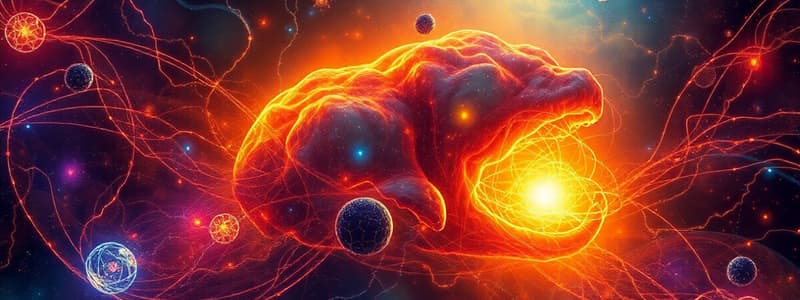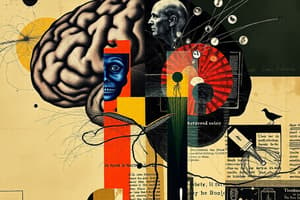Podcast
Questions and Answers
Which structure is MOST directly involved in attaching emotional significance to memories?
Which structure is MOST directly involved in attaching emotional significance to memories?
- Cingulate Gyrus
- Hippocampus
- Fornix
- Amygdala (correct)
Damage to the hippocampus is most likely to result in difficulties with which of the following?
Damage to the hippocampus is most likely to result in difficulties with which of the following?
- Processing olfactory stimuli
- Forming new declarative memories (correct)
- Regulating autonomic functions
- Coordinating motor movements
Which of the following is a primary function of the hypothalamus?
Which of the following is a primary function of the hypothalamus?
- Maintaining homeostasis through hormonal regulation (correct)
- Regulating emotions such as fear and aggression
- Facilitating language comprehension
- Coordinating sensory input from vision
Which structure relays emotional and sensory information to the cerebral cortex?
Which structure relays emotional and sensory information to the cerebral cortex?
What is TRUE about the Papez circuit?
What is TRUE about the Papez circuit?
Which of the following conditions involves early degeneration in the hippocampus, leading to memory loss?
Which of the following conditions involves early degeneration in the hippocampus, leading to memory loss?
What is the MOST likely behavioral change resulting from bilateral damage to the amygdala, as seen in Klüver-Bucy Syndrome?
What is the MOST likely behavioral change resulting from bilateral damage to the amygdala, as seen in Klüver-Bucy Syndrome?
Hyperactivity in which of the following brain structures is commonly associated with Post-Traumatic Stress Disorder (PTSD)?
Hyperactivity in which of the following brain structures is commonly associated with Post-Traumatic Stress Disorder (PTSD)?
Where is the amygdala located in relation to the hippocampus?
Where is the amygdala located in relation to the hippocampus?
The limbic system forms a ring-like structure around which brain structure?
The limbic system forms a ring-like structure around which brain structure?
Which area integrates emotion with cognitive functions such as decision-making and impulse control?
Which area integrates emotion with cognitive functions such as decision-making and impulse control?
What is the role of the Fornix within the limbic system?
What is the role of the Fornix within the limbic system?
Which structure is most closely associated with reward and reinforcement within the limbic system?
Which structure is most closely associated with reward and reinforcement within the limbic system?
The limbic system regulates the body’s stress response via which axis?
The limbic system regulates the body’s stress response via which axis?
Which of the following structures is NOT considered a core structure of the limbic system?
Which of the following structures is NOT considered a core structure of the limbic system?
What is the primary role of the orbitofrontal cortex?
What is the primary role of the orbitofrontal cortex?
Which condition is characterized by emotional blunting, hyperphagia, and hypersexuality due to bilateral damage to the amygdala?
Which condition is characterized by emotional blunting, hyperphagia, and hypersexuality due to bilateral damage to the amygdala?
If a person has difficulty with spatial memory and recognizing scenes, which area is MOST likely affected?
If a person has difficulty with spatial memory and recognizing scenes, which area is MOST likely affected?
The direct connection of the olfactory bulb to the limbic system explains why smell is strongly associated with what?
The direct connection of the olfactory bulb to the limbic system explains why smell is strongly associated with what?
Which of the following is MOST likely to occur if the anterior thalamus is damaged?
Which of the following is MOST likely to occur if the anterior thalamus is damaged?
Flashcards
Limbic System
Limbic System
A complex set of brain structures involved in emotion, memory, motivation, and behavioral regulation.
Hippocampus
Hippocampus
Critical for forming new memories and spatial navigation.
Amygdala
Amygdala
Processes emotions, especially fear and aggression, and attaches emotional significance to memories.
Cingulate Gyrus
Cingulate Gyrus
Signup and view all the flashcards
Parahippocampal Gyrus
Parahippocampal Gyrus
Signup and view all the flashcards
Fornix
Fornix
Signup and view all the flashcards
Hypothalamus
Hypothalamus
Signup and view all the flashcards
Mammillary Bodies
Mammillary Bodies
Signup and view all the flashcards
Septal Nuclei
Septal Nuclei
Signup and view all the flashcards
Orbitofrontal Cortex
Orbitofrontal Cortex
Signup and view all the flashcards
Thalamus (Anterior Nucleus)
Thalamus (Anterior Nucleus)
Signup and view all the flashcards
Olfactory Bulb
Olfactory Bulb
Signup and view all the flashcards
Prefrontal Cortex Connection
Prefrontal Cortex Connection
Signup and view all the flashcards
Temporal Lobe Connection
Temporal Lobe Connection
Signup and view all the flashcards
Hypothalamus Connection
Hypothalamus Connection
Signup and view all the flashcards
Anterior Thalamus Connection
Anterior Thalamus Connection
Signup and view all the flashcards
Papez Circuit
Papez Circuit
Signup and view all the flashcards
Brainstem Connections
Brainstem Connections
Signup and view all the flashcards
Hippocampus Role
Hippocampus Role
Signup and view all the flashcards
Septal Nuclei and Motivation
Septal Nuclei and Motivation
Signup and view all the flashcards
Study Notes
- The limbic system is a set of brain structures involved in emotion, memory, motivation, and behavioral regulation.
- It bridges higher cognitive functions and primitive brain structures responsible for instinctual responses.
Subdivisions
- The limbic system has core and associated structures.
Core Structures
- The hippocampus is critical for forming new memories and spatial navigation.
- The amygdala processes emotions, especially fear and aggression, and attaches emotional significance to memories.
- The cingulate gyrus is involved in emotional regulation, pain processing, and attention.
- The parahippocampal gyrus is important for spatial memory and scene recognition.
- The fornix connects the hippocampus to the hypothalamus and is involved in memory consolidation.
Associated Structures
- The hypothalamus regulates autonomic functions, hormonal activity, and homeostasis.
- The mammillary bodies play a role in recollective memory.
- The septal nuclei are associated with reward and reinforcement.
- The orbitofrontal cortex is involved in decision-making and emotional evaluation.
- The anterior nucleus of the thalamus relays emotional and sensory information to the cortex.
- The olfactory bulb is directly linked to the processing of smell, which has strong connections to emotional memory.
Location
- The limbic system is located on both sides of the thalamus, underneath the cerebral cortex.
- It forms a ring-like structure around the corpus callosum.
- The hippocampus is located in the medial temporal lobe.
- The amygdala is anterior to the hippocampus in the medial temporal lobe.
- The cingulate gyrus curves around the corpus callosum.
- The hypothalamus and mammillary bodies are located at the base of the brain below the thalamus.
Connections with Other Brain Parts
- The limbic system interacts extensively with various brain regions through afferent and efferent pathways.
Connections to the Cerebral Cortex
- The prefrontal cortex integrates emotion with cognitive functions like decision-making and impulse control.
- The temporal lobe facilitates memory storage and retrieval.
Connections to the Hypothalamus
- Regulates autonomic and endocrine responses, such as stress and arousal.
Connections to the Thalamus
- The anterior nucleus relays information between the limbic system and the cerebral cortex, especially in emotional and memory processing.
Papez Circuit
- The Papez circuit involves the hippocampus, fornix, mammillary bodies, anterior thalamus, and cingulate gyrus.
- It is essential for consolidating declarative memory.
Connections to the Brainstem
- Modulates arousal, wakefulness, and autonomic responses.
Significance
- The limbic system plays roles in key brain functions.
Emotional Regulation
- Processes primary emotions like fear, pleasure, and anger.
- The amygdala is crucial for recognizing emotional stimuli and initiating fight-or-flight responses.
Memory Formation and Retrieval
- The hippocampus encodes new declarative memories and facilitates their consolidation.
- Damage to the hippocampus can cause anterograde amnesia.
Motivation and Reward
- The septal nuclei and hypothalamus are linked to reward-seeking behaviors.
- Dysregulation is implicated in addiction.
Autonomic and Endocrine Regulation
- The hypothalamus coordinates the body’s homeostasis, like temperature, hunger, and hormone release.
- Limbic structures regulate the stress response via the hypothalamic-pituitary-adrenal (HPA) axis.
Social Behavior and Attachment
- The amygdala and cingulate gyrus play roles in social bonding and empathy.
Clinical Significance
- In Alzheimer’s Disease early degeneration occurs in the hippocampus, leading to memory loss.
- Klüver-Bucy Syndrome involves bilateral damage to the amygdala, resulting in emotional blunting, hyperphagia, and hypersexuality.
- In Post-Traumatic Stress Disorder (PTSD) there is hyperactivity of the amygdala and reduced hippocampal volume.
- Temporal lobe epilepsy often involves the hippocampus.
Studying That Suits You
Use AI to generate personalized quizzes and flashcards to suit your learning preferences.



